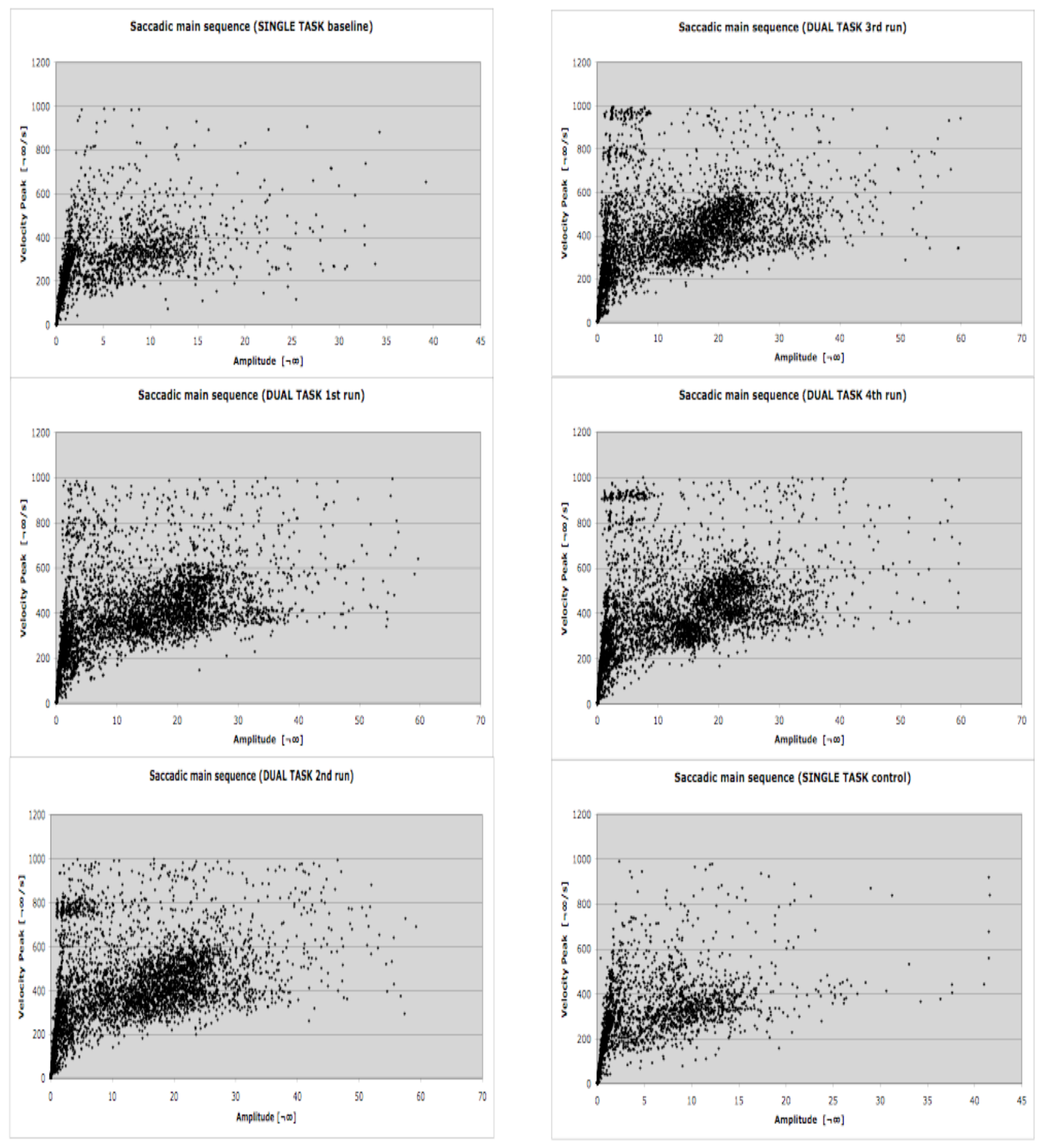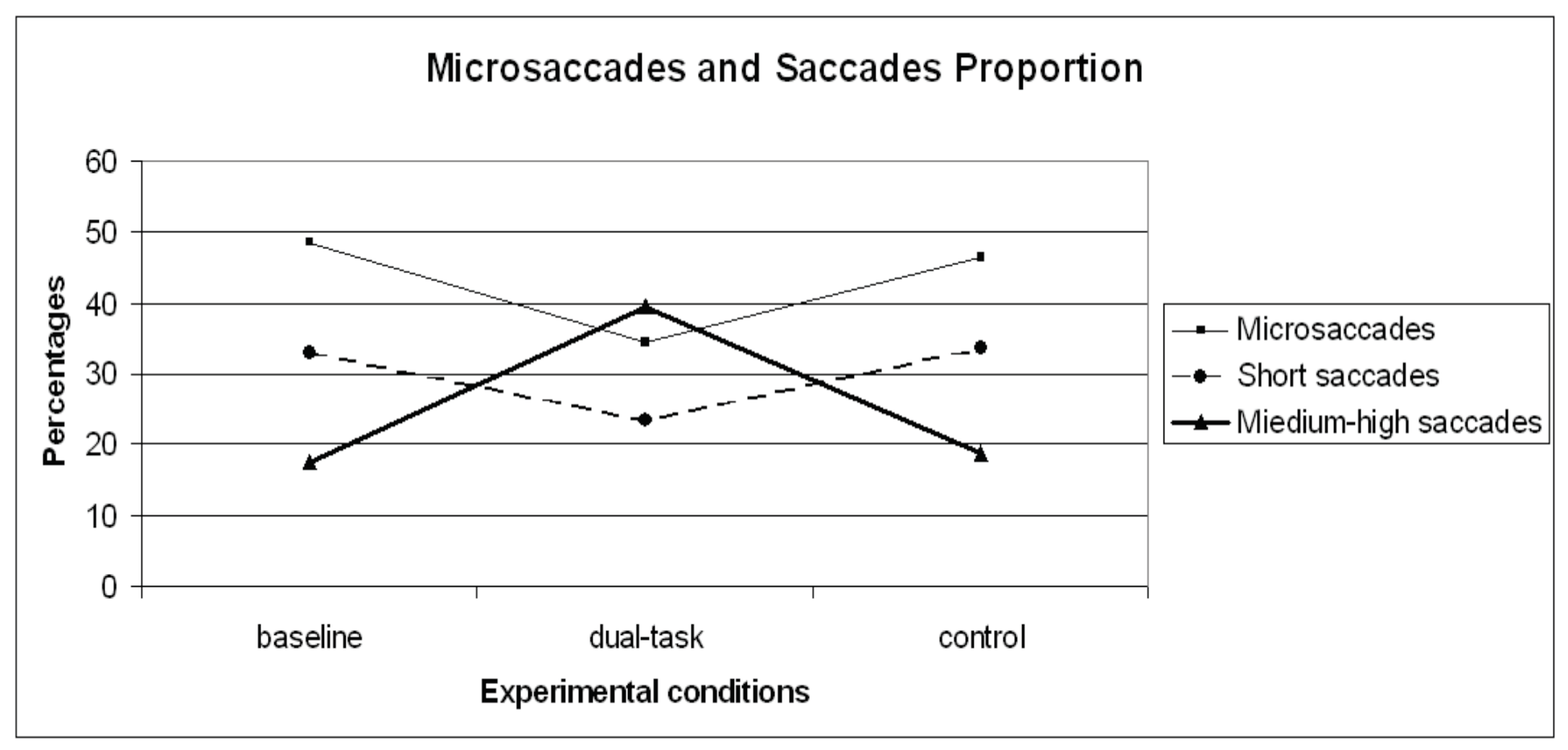Microsaccades and Exploratory Saccades in a Naturalistic Environment
Abstract
:1. Introduction
2. Method
2.1. Experimental plan
2.1. Eyetracking Apparatus
2.2. Secondary Task
2.3. Dependent Variables
3. Results
3.1. Microsaccade and Saccade frequency
- -
- from 1° to 10° (labelled short);
- -
- from 10° to 60° (labelled medium-high).
3.2. Microsaccade and Saccade proportion
3.3. Fixation frequency and Average fixation duration
4. Discussion
References
- Backs, R. W., and L. C. Walrath. 1992. Eye movement and pupillary response indices of mental workload during visual search of symbolic displays. Applied Ergonomics 23: 243–254. [Google Scholar] [CrossRef] [PubMed]
- Beeler, G. W. 1967. Visual threshold changes resulting from spontaneous saccadic eye movements. Vision Research 7: 769–775. [Google Scholar] [CrossRef]
- Benedetto, S., M. Pedrotti, L. Minin, T. Baccino, A. Re, and R. Montanari. 2011. Driver workload and eye blink duration. Transportation research part F 14, 3: 199–208. [Google Scholar] [CrossRef]
- Betta, E., G. Galfano, and M. Turatto. 2007. Microsaccadic response during inhibition of return in a target-target paradigm. Vision Research 47: 428–436. [Google Scholar] [CrossRef] [PubMed]
- Bridgeman, B., and B. Fisher. 1990. Saccadic suppression of displacement is strongest in central vision. Perception 19: 103–111. [Google Scholar] [CrossRef]
- Bridgeman, B., D. Hendry, and L. Stark. 1975. Failure to detect displacement of the visual world during saccadic eye movements. Vision Research 15: 719–722. [Google Scholar] [CrossRef]
- Bridgeman, B., and J. Palca. 1980. The role of microsaccades in high acuity observational tasks. Vision Research 20: 813–817. [Google Scholar] [CrossRef]
- Cui, J., M. Wilke, N.K. Logothetis, D.A. Leopold, and H. Liang. 2009. Visibility states modulation microsaccade rate and direction. Vision Research 49, 2: 228–36. [Google Scholar] [CrossRef]
- De Waard, D. 1996. The measurement of drivers' mental workload. PhD thesis, University of Groningen, Traffic Research Centre, University of Groningen. Haren, The Netherlands. [Google Scholar]
- Ditchburn, R. W. 1973. Eye-movements and visual perception. Oxford: Clarendon Press. [Google Scholar]
- Ditchburn, R. W., and B. L. Ginsborg. 1952. Vision with a stabilized retinal image. Nature 170: 36–37. [Google Scholar] [CrossRef]
- Ditchburn, R. W., and B. L. Ginsborg. 1953. Involuntary eye movements during fixation. Journal of Physiology 119: 1–17. [Google Scholar] [CrossRef]
- Engbert, R., and R. Kliegl. 2003. Microsaccades uncover the orientation of covert attention. Vision Research 15: 1035–1045. [Google Scholar] [CrossRef] [PubMed]
- Engbert, R., and R. Kliegl. 2004. Microsaccades keep the eyes' balance during fixation. Psychological Science 43: 431–436. [Google Scholar] [CrossRef] [PubMed]
- Engbert, R., and K. Mergenthaler. 2006. Microsaccades are triggered by low retinal image slip. Proceedings of the National Academy of Sciences 103, 18: 7192–7197. [Google Scholar] [CrossRef] [PubMed]
- Galfano, G., E. Betta, and M. Turatto. 2004. Inhibition of return in microsaccades. Experimental Brain Research 159: 400–404. [Google Scholar] [CrossRef]
- Hafed, Z. M., and J. J. Clark. 2002. Microsaccades as an overt measure of covert attention shifts. Vision Research 42: 2533–2545. [Google Scholar] [CrossRef]
- Hafed, Z. M., L. Goffart, and R. J. Krauzlis. 2009. A neural mechanism for microsaccade generation in the primate superior colliculus. Science 323: 940–943. [Google Scholar] [CrossRef]
- Horowitz, T. S., E. M. Fine, D. E. Fenesik, S. Yurgenson, and J. M. Wolfe. 2007a. Fixational eye movements are not an index of covert attention. Psychological Science 18: 356–363. [Google Scholar] [CrossRef]
- Horowitz, T. S., E. M. Fine, D. E. Fenesik, S. Yurgenson, and J. M. Wolfe. 2007b. Microsaccades and attention: Does a weak correlation make an index? Psychological Science 18: 367–368. [Google Scholar] [CrossRef]
- Irwin, D. E. 1992. Memory for position and identity across eye movements. Journal of Experimental Psychology: Learning, Memory and Cognition 18: 307–317. [Google Scholar] [CrossRef]
- ISO/DIS 26022. 2007. Road vehicles – Ergonomic aspects of transport information and control systems – Simulated lane change test to assess in-vehicle secondary task demand. ISO/TC 22/SC 13 - ICS 13.180; 43.040.15. [Google Scholar]
- Ko, H. K., M. Poletti, and M. Rucci. 2010. Microsaccades precisely relocate gaze in a high visual acuity task. Nature Neuroscience 13: 1549–1553. [Google Scholar] [CrossRef]
- Kowler, E., and R. M. Steinman. 1980. Small saccades serve no useful purpose. Vision Research 20: 273–276. [Google Scholar] [CrossRef] [PubMed]
- Lansdown, T. C. 2000. Edited by P. A. Hancock and P. A. Desmond. Causes, measures, and effects of driver visual workload. In Stress, workload, and fatigue. Mahwah: Lawrence Erlbaum: pp. 351–369. [Google Scholar]
- Laubrock, J., R. Engbert, and R. Kliegl. 2005. Microsaccade dynamics during covert attention. Vision Research 45: 721–730. [Google Scholar] [CrossRef]
- Laubrock, J., R. Kliegl, M. Rolfs, and R. Engbert. 2010. When do microsaccades follow spatial attention? Attention. Perception, & Psychophysics 72: 683–694. [Google Scholar]
- Leopold, D. A., and N. K. Logothetis. 1998. Microsaccades differentially modulate neural activity in the striate and extrastriate visual cortex. Experimental Brain Research 123: 341–345. [Google Scholar] [CrossRef]
- Martinez-Conde, S., S. L. Macknik, and D. H. Hubel. 2000. Microsaccadic eye movements and firing of single cells in the striate cortex of macaque monkeys. Nature Neuroscience 3: 251–258. [Google Scholar] [CrossRef] [PubMed]
- Martinez-Conde, S., S. L. Macknik, and D. H. Hubel. 2002. The function of bursts of spikes during visual fixation in the awake primate lateral geniculate nucleus and primary visual cortex. Proceedings of the National Academy of Sciences 99: 13920–13925. [Google Scholar] [CrossRef]
- Martinez-Conde, S., S. L. Macknik, and D. H. Hubel. 2004. The role of fixational eye movements in visual perception. Nature Reviews Neuroscience 5: 229–240. [Google Scholar] [CrossRef]
- Martinez-Conde, S., S. L. Macknik, X. G. Troncoso, and T. A. Dyar. 2006. Microsaccades counteract visual fading during fixation. Neuron 49: 297–305. [Google Scholar] [CrossRef]
- Martinez-Conde, S., S. L. Macknik, X. Troncosco, and D. H. Hubel. 2009. Microsaccades: a neurophysiological analysis. Trends in Neurosciences 32: 463–475. [Google Scholar] [CrossRef]
- Matin, E. 1974. Saccadic suppression: A review and an analysis. Psychological Bulletin 81: 899–917. [Google Scholar] [CrossRef]
- Mattes, S. 2003. Edited by H. Strasser, H. Rausch and H. Bubb. The lane change task as a tool for driver distraction evaluation. In Quality of Work and Products in Enterprises of the Future. Stuttgart: Ergonomia Verlag: pp. 57–60. [Google Scholar]
- Mergenthaler, K., and R. Engbert. 2010. Microsaccades are different from saccades in scene perception. Experimental Brain Research 203: 753–757. [Google Scholar] [CrossRef] [PubMed]
- Miura, T. 1986. Edited by A. G. Gale, M. H. Freeman, C. M. Haslegrave, P. Smith and S. P. Taylor. Coping with situational demands: A study of eye-movements and peripheral vision performance. In Vision in vehicles. Amsterdam: North-Holland: pp. 126–137. [Google Scholar]
- O'Donnell, R.D., and F.T. Eggemeier. 1986. Edited by K. Boff, L. Kaufman and J. Thomas. Workload Assessment Methodology. In Handbook of Perception and Human Performance, Vol. II: Cognitive Processes and Performance. New York: Wiley Interscience. [Google Scholar]
- Otero-Millan, J., X. G. Troncoso, S. L. Macknik, I. Serrano-Pedraza, and S. Martinez-Conde. 2008. Saccades and microsaccades during visual fixation exploration, and search: Foundations for a common saccadic generator. Journal of Vision 8, 14: 1–18. [Google Scholar] [CrossRef] [PubMed]
- Poletti, M., and M. Rucci. 2010. Eye movements under various conditions of image fading. Journal of Vision 10, 3: 1–18. [Google Scholar] [CrossRef]
- Posner, M. I., and Y. Cohen. 1984. Edited by H. Bouma and D. G. Bouwhuis. Components of visual orienting. In Attention and performance X: Control of language processes. Hillsdale, NJ: Erlbaum: pp. 531–556. [Google Scholar]
- Posner, M. I., M. J. Nissen, and W. C. Ogden. 1978. Edited by H. L. Pick and B. J. Saltzman. Attended and unattended processing modes: The role of set in spatial locations. In Modes of perceiving and processing information. Hillsdale, NJ: Erlbaum: pp. 137–158. [Google Scholar]
- Pritchard, R. M. 1961. Stabilized images on the retina. Scientific American 204: 72–78. [Google Scholar] [CrossRef]
- Ratliff, F., and L. A. Riggs. 1950. Involuntary motions of the eye during monocular fixation. Journal of Experimental Psychology 40: 687–700. [Google Scholar] [CrossRef] [PubMed]
- Rayner, K., and R. K. Morris. 1990. Edited by R. Groner, G. d'Ydewalle and R. Parham. Do eye-movements reflect higher order processes in reading? In From eye to mind. Information acquisition in perception, search, and reading. Amsterdam: North-Holland: pp. 191–204. [Google Scholar]
- Rolfs, M. 2009. Microsaccades: Small steps on a long way. Vision Research 49: 2415–2441. [Google Scholar] [CrossRef]
- Salvucci, D. D., and J. H. Goldberg. 2000. Edited by A. T. Duchowsky. Identifying fixations and saccades in eye-tracking protocols. In Proceedings of the eye tracking research and applications symposium. New York: ACM Press: pp. 71–78. [Google Scholar]
- SMI–SensoMotoric Instruments. 2009. Begaze 2.2 manual. Germany: Teltow. [Google Scholar]
- Tse, P. U., D. L. Sheinberg, and N. K. Logothetis. 2004. The distribution of microsaccade directions need not reveal the location of attention. Psychological Science 15: 708–10. [Google Scholar] [CrossRef]
- Tse, P. U., D. L. Sheinberg, and N. K. Logothetis. 2002. Fixational eye movements are not affected by abrupt onsets that capture attention. Vision Research 42: 1663–1669. [Google Scholar] [CrossRef]
- Turatto, M., M. Valsecchi, L. Tame, and E. Betta. 2007. Microsaccades distinguish between global and local visual processing. Neuroreport 18: 1015–1018. [Google Scholar] [CrossRef]
- Underwood, G., and R. Radach. 1998. Edited by G. Underwood. Eye guidance and human information processing: Reading, visual search, picture perception, and driving. In Eye guidance in reading and scene perception. Oxford, England: Elsevier: pp. 1–28. [Google Scholar]
- Wickens, C. D. 2002. Multiple Resources and performance prediction. Theoretical Issues In Ergonomics Science 3: 159–177. [Google Scholar] [CrossRef]
- Wilson, G. F., and F. T. Eggemeier. 1991. Edited by D. Damos. Physiological measures of workload in multi-task environments. In Multiple-task performance. London: Taylor & Francis: pp. 329–360. [Google Scholar]
- Winterson, B. J., and H. Collewijn. 1976. Microsaccades during finely guided visuomotor tasks. Vision Research 16: 1387–1390. [Google Scholar] [CrossRef] [PubMed]
- Young, K., and M. Regan. 2007. Edited by I. J. Faulks, M. Regan, M. Stevenson, J. Brown, A. Porter and J. D. Irwin. Driver distraction: A review of the literature. In Distracted driving. Sydney, NSW: Australasian College of Road Safety: pp. 379–405. [Google Scholar]
- Zuber, B. L., and L. Stark. 1966. Saccadic suppression: Elevation of visual threshold associated with saccadic eye movements. Experimental Neurology 16: 65–79. [Google Scholar] [CrossRef] [PubMed]
- Zuber, B. L., L. Stark, and G. Cook. 1965. Microsaccades and the velocity-amplitude relationship for saccadic eye movements. Science 150: 1459–1460. [Google Scholar] [CrossRef] [PubMed]





Copyright © 2011. This article is licensed under a Creative Commons Attribution 4.0 International License.
Share and Cite
Benedetto, S.; Pedrotti, M.; Bridgeman, B. Microsaccades and Exploratory Saccades in a Naturalistic Environment. J. Eye Mov. Res. 2011, 4, 1-10. https://doi.org/10.16910/jemr.4.2.2
Benedetto S, Pedrotti M, Bridgeman B. Microsaccades and Exploratory Saccades in a Naturalistic Environment. Journal of Eye Movement Research. 2011; 4(2):1-10. https://doi.org/10.16910/jemr.4.2.2
Chicago/Turabian StyleBenedetto, Simone, Marco Pedrotti, and Bruce Bridgeman. 2011. "Microsaccades and Exploratory Saccades in a Naturalistic Environment" Journal of Eye Movement Research 4, no. 2: 1-10. https://doi.org/10.16910/jemr.4.2.2
APA StyleBenedetto, S., Pedrotti, M., & Bridgeman, B. (2011). Microsaccades and Exploratory Saccades in a Naturalistic Environment. Journal of Eye Movement Research, 4(2), 1-10. https://doi.org/10.16910/jemr.4.2.2


